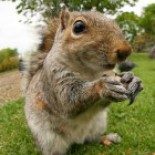Searching for monkeyflowers in California
Gallery: Click on the first picture and Kelly Carscadden (EEB) will walk you through her fieldwork.

For two months last summer, I traveled across California through 11 national parks, preserves, and national forests to collect monkeyflower (Mimulus) seeds.

Driving from San Bernardino in the south, along the Sierra Nevada Mountains to Shasta-Trinity, and back, twice, I captured as many populations of monkeyflowers as I could manage across this 6500 mile traverse.

I begin the day with campfire-made oatmeal and tea. Then, before the sun gets too high, I put on my long sleeves, hat, and sunscreen, and take down my tent.

Each day, I pack a GPS and camera, maps, permits and taxonomic keys, water, medical and survival kits, a trowel for digging up plants, and tiny envelopes for collecting seeds.

As I drive, I scan for the flowers’ favourite habitats. Some species like the open, disturbed areas, occurring in larger, eye-catching patches. Others make their home in disjointed pockets, clustered along a stream or meadow edge, or peaking out from a rock crevice.

Sometimes nothing is visible from the road and I have to hike some 10km, navigating riverbeds and steep terrain.

I’m mostly here for the monkeyflower seeds. They are dust-like and need careful containment when collecting.

The seeds will help me understand why some species of monkeyflower grow almost anywhere with a good water supply, while others are quite particular. Picky plants are more often rare and therefore vulnerable to extinction.

For example, shield-bracted monkeyflower (Mimulus glaucescens), which grows along springs in only a few places in California, has distinguishing disc-like leaves under the developing fruits, while Mimulus guttatus, the famous common yellow monkeyflower, is less particular in its habitat.

If we can measure how picky a species is, we can better predict how it will respond to changing environmental conditions. Despite knowing that tolerances can vary dramatically over a species’ range, we often survey only a few populations when measuring a species’ tolerance. Here, I am sampling many tens of monkeyflower populations in hopes of more fully characterizing several species’ tolerances.

Sometimes my luck runs out and I can’t find any monkeyflowers in an area. Or I find them but arrive too early, and they are all still in flower, or too late, and the seeds have already dropped to the ground.

Whenever I collect seeds, I press a few plants from that population. These will go to a herbarium as a public record of that population, so others can independently identify the plants.

To identify a monkeyflower, I rely on several characteristics. Flowers are very useful, as are purple rhizomes from which they can spring additional shoots.

I rely on leaf shape, how the leaves join the stem, and the curve of the lobes of the fruit when flowers have dried up.

Some monkeyflower species grow in unusual environments; I found primrose monkeyflowers (Mimulus primuloides) growing next to a carnivorous sundew plant.

I wasn’t always alone; my mom—Momulus, as she became—-joined me for the tail end of my trip. She became an expert at taking GPS coordinates, making site descriptions, and spotting populations.

After a day in the field, we would drive to a campsite (we became skilled at tent assembly by head lamp), enjoy some rehydrated dinner, plan the day ahead, and tape up the seeds we collected that day.

By the end of the season, we’ve collected seeds from 80 populations, ready to be potted up in a greenhouse. I’ll be growing up these seeds to see how well they do under different environmental conditions and explore which plant characteristics are advantageous under wet or dry treatments. Stay tuned for results.



















